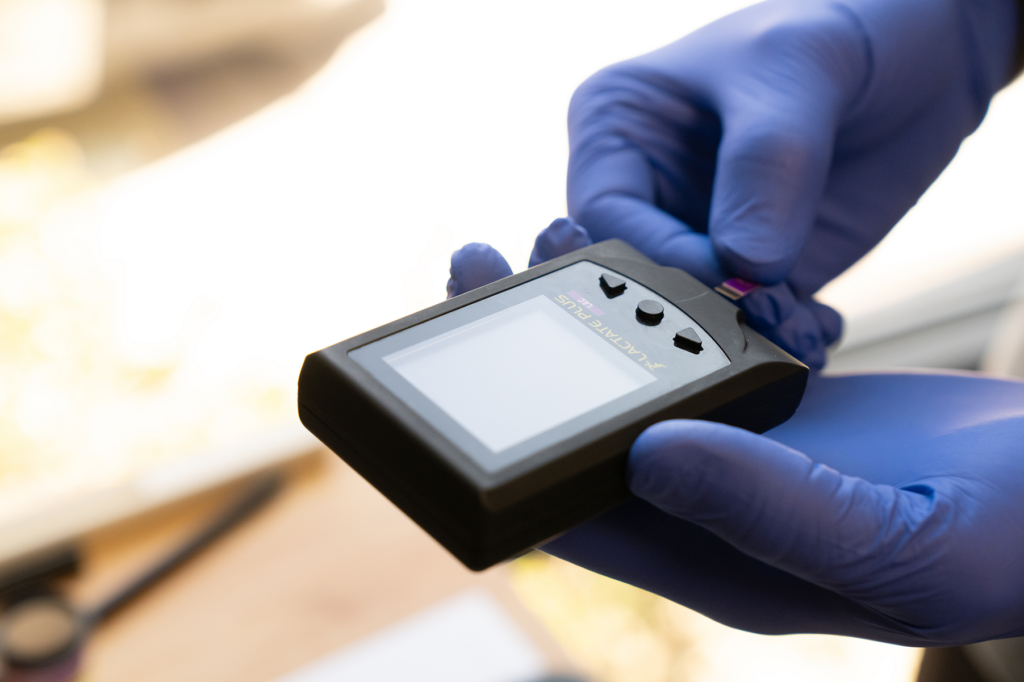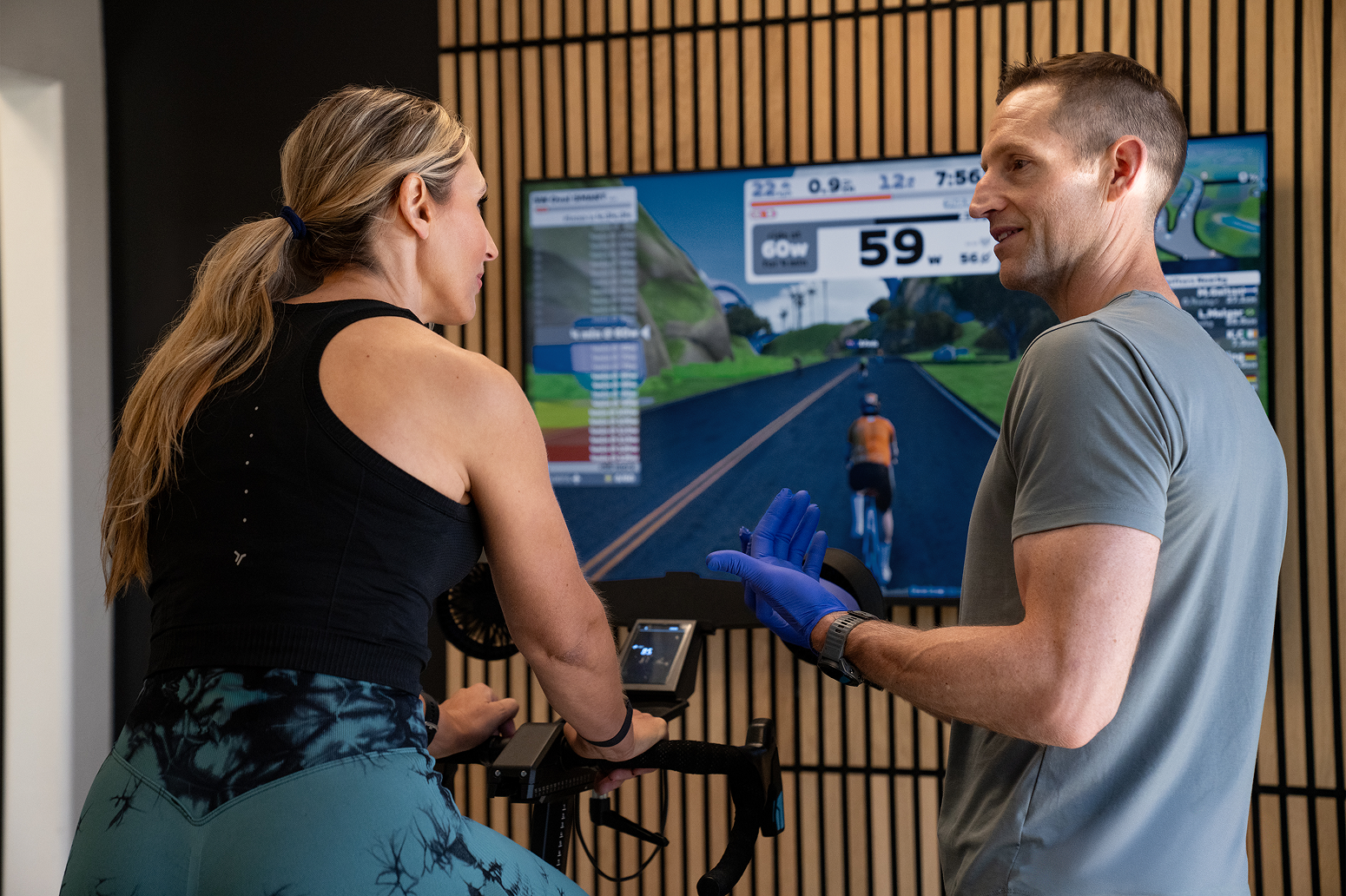The Precision of Personalized Training
At Clay, we believe that optimal health and performance stem from understanding your body’s unique physiology. Zone 2 training—exercising at a specific heart rate zone to maximize fat oxidation and mitochondrial efficiency—is foundational to this approach.
To accurately determine an individual’s true Zone 2, we collaborate with Oval, utilizing their advanced lactate threshold testing technology. This partnership allows us to tailor training programs that align with each client’s metabolic profile, ensuring effective and sustainable results.
Before Anything Else, You Need to Understand Lactate Threshold.
Lactate threshold refers to the exercise intensity at which lactate begins to accumulate in the bloodstream faster than it can be removed. This point is crucial because it signifies a shift from predominantly aerobic metabolism to anaerobic metabolism. Training just below this threshold—within Zone 2—enhances mitochondrial density and function, improving the body’s ability to utilize oxygen for energy production.

In my own training, I’ve learned firsthand how staying just below this threshold improves my endurance and metabolic efficiency over time. It’s humbling, but necessary, to slow down to truly build capacity. With patients at Clay, I’ve seen remarkable improvements in fatigue resistance and metabolic markers after consistent training in their personalized Zone 2 ranges.
Studies have shown that consistent Zone 2 training increases the activity of mitochondrial enzymes, leading to better endurance and metabolic health (Coyle et al., 1991; San-Millán & Brooks, 2018; Laursen & Jenkins, 2002).
Making Room for Zone 2 In Your Workouts
Incorporating Zone 2 training into your routine doesn’t require exhaustive efforts. Activities like brisk walking, cycling, or light jogging, maintained at a pace where conversation is comfortable, are effective. I advise clients to find that pace where they’re just under the edge—breathing deeply but not gasping. That’s the sweet spot.
Personally, I aim for 45 minutes of Zone 2 jogging or cycling 3-4 times a week, keeping my heart rate dialed into my lactate threshold insights from Oval. That feedback keeps me honest and efficient. I recommend the same for most clients who regularly exercise: 30-60 minutes, 3-5 times per week, depending on goals and baseline fitness.
We also encourage flexibility. If you’re on your feet all day or have a hard workout planned tomorrow, 30 minutes of Zone 2 is plenty.
For more tips, check out Inigo San-Millán, one of the leading voices in lactate metabolism research, and Peter Attia’s work, who regularly covers the longevity impact of Zone 2 training.
Integrating Zone 2 into Clay’s Health Optimization Programs
At Clay, our Health Optimization clients benefit from personalized programs that incorporate Zone 2 training as a cornerstone. During onsite appointments at Clay clinics, I walk clients through lactate threshold testing myself, explaining what we’re measuring and how the data applies to their daily lives.
By identifying each individual’s lactate threshold through Oval’s testing, we tailor exercise prescriptions that align with their metabolic capabilities and goals. This approach ensures that clients train efficiently, avoid overtraining, and achieve sustainable improvements in health and performance.
To see our approach in action, here’s Clay CEO, Joel Nelson breaking down a lactate threshold test using Oval’s technology at our Henderson, NV clinic:
Oval’s portable lactate meter and software give us real-time visibility into how your body uses energy across intensities. This test helps us personalize both low-intensity endurance work and high-intensity intervals for smarter gains.

Finding the sweet spot. A Clay Coach uses Oval’s lactate pulse tech to uncover True Zone 2—where endurance gains and fat burn really take off.
Elite Tools Belong To Everyone
Our mission at Clay is to democratize access to elite-level health and performance tools. By leveraging data-driven assessments like lactate threshold testing, we provide clients with insights previously reserved for professional athletes.
We believe that everyone deserves to understand their body on a deeper level. That means replacing guesswork with measurement, and ambition with a smart plan. By combining assessments with health coaching, we help each person move toward a more metabolically flexible and physically capable version of themselves.
What Metabolic Insights Do We Gain?
Lactate threshold testing provides valuable insights into an individual’s metabolic responses during exercise. By identifying the precise point where lactate begins to accumulate, we can determine the true Zone 2 heart rate range, ensuring that training is both effective and safe.
This is where fat oxidation peaks—Zone 2 is your body’s fat-burning engine. Beyond that threshold, your body shifts to burning primarily carbohydrates. So when you’re training just below that point, you’re training your body to become metabolically flexible.
We also use this test to define Zone 5—your max output—used in high-intensity intervals. This clarity allows for intentional, polarized training that combines smart recovery and smart intensity.
More info on this can be found via Heart Rate Training by Phil Maffetone and Steven Seiler’s polarized training research.
MetFlex Index: Measuring Metabolic Fitness
At Clay, we utilize the MetFlex Index to assess an individual’s metabolic flexibility—the ability to efficiently switch between fuel sources like fats and carbohydrates. A higher MetFlex Index indicates a more adaptable metabolism, which is associated with better health outcomes and performance.
We score metabolic fitness based on data from the lactate test and combine it with insights from body composition, nutrition intake, and recovery patterns. This comprehensive view empowers us to design health strategies that build long-term resilience—not just short-term performance.
Empowering Health Through Precision
By partnering with Oval and integrating lactate threshold testing into our programs, Clay provides clients with the tools and insights necessary for personalized, effective training. This approach not only enhances performance but also promotes longevity. Through data-driven strategies and a commitment to accessibility, we empower individuals to take control of their health journeys and understand their own inner workings on a deeper, metabolic level. It’s a fantastic “ah-ha” moment to witness and one of the true highlights of my job here at Clay.
Sources
- Heart Rate Acquisition and Threshold-Based Training Increases Oxygen Uptake at Metabolic Threshold in Triathletes: A Pilot Study
- The Relationship Between Lactate and Ventilatory Thresholds in Runners: Validity and Reliability of Exercise Test Performance Parameters
- What is the SMART Test? Oval
- Zone 2 Training & Lactate: Dissecting Iñigo San Millán’s Advice
- Blood Lactate in Training, Part 2: LT1 and Zone 2 Training For Performance and Longevity
- The science behind Zone 2 training for athletes
- Why Easy ‘Zone 2’ Workouts Became the Biggest Thing in Fitness

